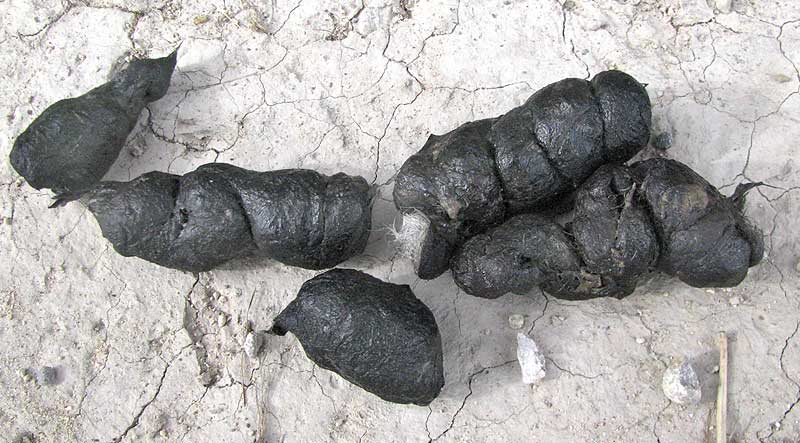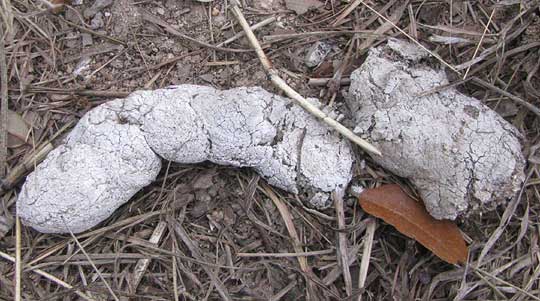Excerpts from Jim Conrad's
Naturalist Newsletter

from the January 6, 2013 Newsletter issued from the valley of the Dry Frio River in northern Uvalde County, southwestern Texas, on the southern border of the Edwards Plateau; elevation ~1750m (~5750 ft); N29.62°, W99.86°; USA
BLACK SCAT
Along the road I came upon the fresh pile of scat -- animal poop -- shown above.
What animal had bestowed this interesting corporeality? Here's the thought process I went through trying to figure it out:
First, the scat's size eliminates most animals in the neighborhood, the turds being about as thick as my middle finger -- about ¾ inch in diameter (2cm). This was no squirrel or rabbit. Besides, the scat was full of animal fur so this was a carnivore. A close-up of a little pointy turd displaying lots of hair is shown below:

That picture shows that many of the hairs are white, so something other than black hairs constitutes this scat black. Animals eating many blackberries produce black scat, but it's not blackberry season, plus, with all those hairs the black color was surely that of digested blood. This animal definitely was not a vegetarian.
Based just on size, the presence of so much hair, and the black color, the list of local predators that came to mind capable of producing such scat was: Mountain Lion; Bobcat; Coyote, and; homeless dog. We do have Black Bears in the area but their scat tends to be even larger, is blockier, and usually has vegetable matter in it. Fox scat is smaller with the turds more strung together by hair -- ropier and with more tapered ends.
So, now the question becomes whether the scat is feline or canine.
The matter of whether turds have tapered ends or are blunt is important. In general, Coyotes and wild dogs whose diet is heavy with animal prey produce tapered prey, while Bobcats and Mountain Lions produce blunt ones. Our turds seem ambivalent on the matter, but there are more blunt ends than tapered ones.
Also, longish turds can be either "segmented" or unsegmented. Big cats tend to produce segmented ones, while Coyotes and dogs don't. Our scat is somewhat segmented, so there's another vote for "big cat."
These features change enormously depending on the food the animal has eaten so by no means is any particular feature determinative. They are just hints at the pooper's identity. The diet of big cats is usually nearly entirely of flesh, while Coyote scat typically contains at least some vegetable matter, but that situation also varies from poop to poop.
If I'd been lucky, the animal's tracks would have appeared next to the scat, or maybe there would have been signs of the animal scraping the ground after pooping, but this scat resided on hard-backed clay with no dust on it showing signs of post-defecation activity.
Felines sometimes but certainly not always cover their dung with material scraped together with their forepaws, or leave it in scrapes created with their back paws. However, canines also sometimes scrape vigorously and somewhat haphazardly with their hand legs after pooping.
Big cats often mark territory with their scats by leaving them in conspicuous places, as at crossroads. Coyotes might also do this, but do so with less intention, their scat often appearing alongside roads, like ours.
Big cats also tend to mark their territories with multiple scat deposits. In fact, a stone toss away there was indeed another pile of similar scat similarly right beside the road's pavement, but white, as shown below:

That scat is more clearly blunt-ended and segmented than the other. Bobcat scat is known to turn white after a few days of exposure to the elements. I think the main reason it turns white is that the blackness is produced by the remains of blood, which easily decomposes and leaches out with rain. Also there's a lot of bone in Bobcat poop, which contains much calcium carbonate, the semidigested past of which turns white when dry, plus the bone itself is white.
Maybe a more experienced tracker than I could come to an absolute decision about the identity of our poop-leaver, but I can't. Mostly because the turds are fairly segmented, have ends more blocky than tapered, we have two deposits close together, and Mountain Lions are pretty rare around here, I suspect that we have Bobcat poop. This notion is supported by the fact that one night our wildlife camera took a very blurry picture of a Bobcat not a hundred yards from where the scat turned up, plus ranchers around here tend to shoot Coyotes and I'm told that Coyotes are seldom seen.
from the June 20, 2004 Newsletter issued from the woods just west of Natchez, Mississippi, USA
BOBCAT?
Last Sunday morning right after I sent out the Newsletter I mounted my mountain bike and hit Homochitto National Forest's one-lane gravel roads. It was about 90° and very humid, and in the bright sunshine the last thing I expected to see was a Bobcat, LYNX RUFUS. However, maybe I saw exactly that. I'm sure that about 20 feet in front of me a very large, long-legged, bob-tailed cat crossed the road in a pouncing kind of run. The problem is that I didn't see any spots. The cat looked wet, and gray-brown. In fact, it looked exactly like the Lynx in my mammal fieldguide. But Lynxes are mainly Canadian, just entering the US here and there in the far north. I read that Bobcats have about a dozen subspecies, and sometimes the coat tends toward gray-brown, so maybe that's what I saw. I just don't know. Seeing a Bobcat in an isolated part of a national forest wouldn't be terribly unusual, though I think having one cross the road at 10 AM on a sunny day in June is a bit special. Anyone out there with thoughts on this matter?
from the June 27, 2004 Newsletter issued from the woods just west of Natchez, Mississippi, USA
BOBCAT?
After reading my remarks last week about seeing a Bobcat, Roger in Georgia wrote "I saw my bobcat the same morning as you! Mine was a very dark brown and I couldn't make out spots during our brief encounter, but there was only medium light as I was in the woods."
The next day I heard from Larry up at Vicksburg: "I saw a bobcat this evening at 5:00 crossing HWay 433 at a rapid clip... That is the first one I have seen in a long time. I don't know whether our sightings are coincidental or whether for some reason they are moving around a lot in the daylight."
Jerry near Jackson, MS, says he's seen Bobcats in daylight several times. Still, like Larry, I have to wonder why all of a sudden so many of us are seeing Bobcats crossing roads in broad daylight now.